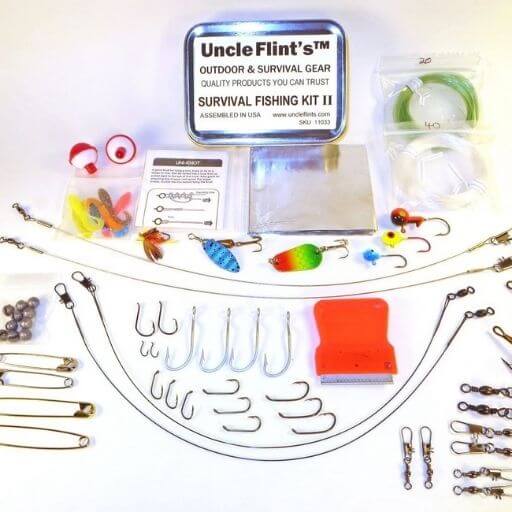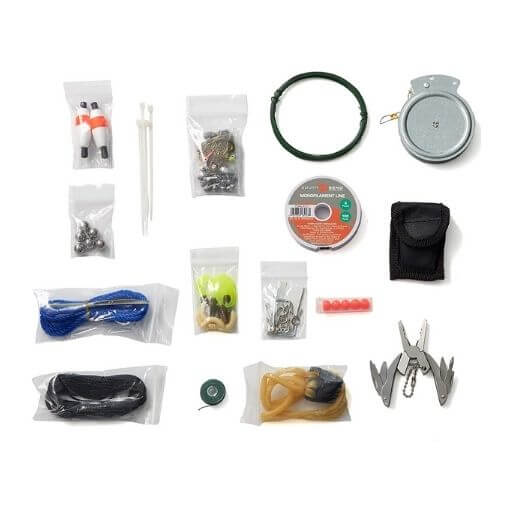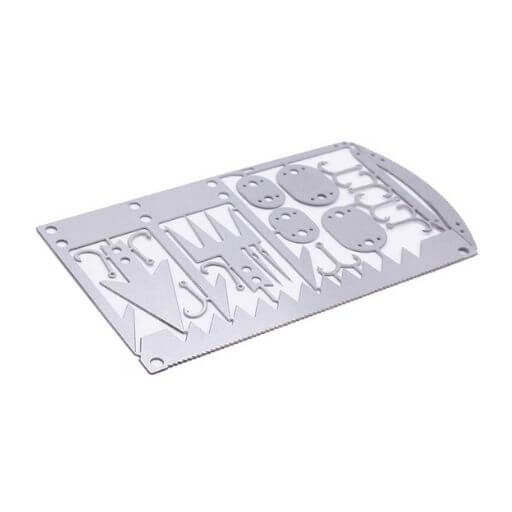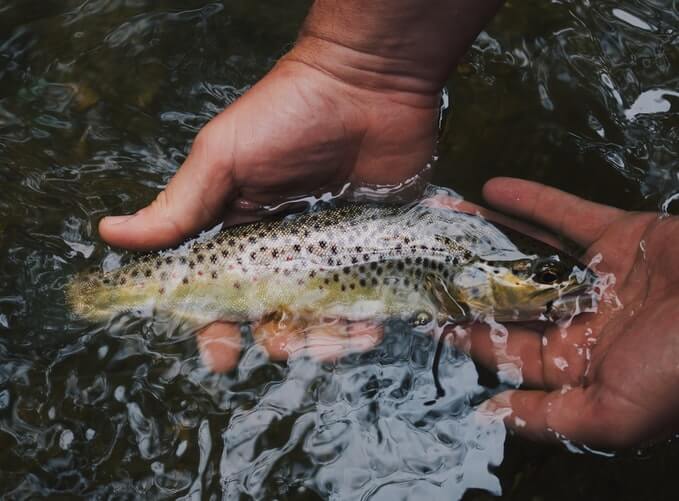Whether you’re lost during a spring hunting trip or stranded on a back road, a survival fishing kit can mean the difference between going hungry and having the strength to make it home.
I’ve tested dozens of survival fishing kits, and I’ll show you exactly what works when you need it most.
Last updated: December 27th, 2024
- Best Overall: Vigilant Trails Pocket Survival Fishing Kit
- Best for Bug-Out Bag: Uncle Flint's Survival Fishing Kit
- Best for Size: Pocket Reel Camping Survival Fishing Kit
- Best to Get Dinner: Stanford Outdoor Supply Fishing and Hunting B.O.S.S.
- Best Wallet-Sized: Buspoll Credit Card Survival Tool
- Why You Need a Survival Fishing Kit
- Survival Fishing Kit Contents
- What Makes a Good Emergency Survival Fishing Kit?
- DIY Survival Fishing Kit: How to Make One Yourself
- Final Thoughts
Best Overall: Vigilant Trails Pocket Survival Fishing Kit

Specs
Pros
Cons
Why I Chose It
After testing dozens of survival fishing kits, I keep coming back to the Vigilant Trails Pocket Survival Fishing Kit-Stage 3. Here’s why:
The kit is quite versatile. It includes 50 feet of 20-pound monofilament line and 9-12 feet of 60-pound nylon line, which means you’ve got options whether you’re after small panfish or something bigger.
One feature I particularly appreciate is the dual reel system. When I tested both passive and active fishing methods, having two reels meant I could set up a stationary line while actively fishing with the other – doubling my chances.
The lure selection is specifically chosen for North American fish species, and in my trials, they proved effective at attracting everything from bass to catfish.
The self-snag hook included in the kit isn’t legal everywhere. Save it for true survival situations only.
Now, if you’ve already got a well-stocked bug-out bag with fishing supplies, you might be better off buying individual components rather than this full kit.
That said, for the price point (under $35), I still think it’s the best choice for a dedicated survival kit in your truck or hunting pack.
Best for Bug-Out Bag: Uncle Flint’s Survival Fishing Kit

Specs
Pros
Cons
Why I Chose It
There’s 1 thing you need to do before buying a cheap survival fishing kit – see why experienced preppers choose Uncle Flint’s Survival Fishing Kit-Type II instead.
This kit packs 63 pieces of quality fishing gear, including 50 feet of 20 lb test line and 50 feet of 40 lb test monofilament for serious catches. During my testing, I could catch everything from small trout to decent-sized bass, and the heavier line handled bigger fish without issue.
Unlike budget kits that skimp on hook variety, Uncle Flint’s includes multiple sizes that work in different waterways. I tested it successfully in both small streams and larger lakes.
This kit is strictly for freshwater fishing and isn’t suitable for saltwater use. If you’re planning coastal bug-out routes, you’ll have to look elsewhere.
While there’s no reel or pole included, here’s a tip: you can make a survival fishing pole with a sapling. Just be sure to attach the line at the base and not the tip. You’ll lose fewer fish and have lower chances of breaking the pole.
It’s not the cheapest at around $30, but I feel the quality and convenience justify this kit‘s cost.
Best for Size: Pocket Reel Camping Survival Fishing Kit

Specs
Pros
Cons
Why I Chose It
This Pocket Reel Emergency Bug-Out Bag Kit will let you catch dinner fast – and at just 2.5 ounces, you may forget that you’re carrying it.
At just 5″x1″, this kit redefines compact survival fishing. I love that the strong test tube container doubles as a reel and is tough enough to survive being tossed around in my truck’s glovebox or carrying bag for months.
With 120 feet of line included, you’ve got plenty of reach for most fishing situations.
Pro tip: If I choose this one as my survival kit, I’ll replace one strand of monofilament with braided line. It’s stronger, more durable, and doesn’t coil up like mono does when stored long-term.
My favorite thing about this kit is that gives you exactly what you need without the fluff. The container even has space for live bait – a game-changer when every cast counts.
If you’ve never fished before, this minimalist kit might be challenging to use. You’ll want to practice with it before relying on it in an emergency.
Overall, for the basic survivalist, this is just about all you need for SHTF (when shit hits the fan) fishing gear.
Best to Get Dinner: Stanford Outdoor Supply Fishing and Hunting B.O.S.S.

Specs
Pros
Cons
Why I Chose It
The Stanford Outdoor Supply B.O.S.S. (Bug Out Survival Supplement) kit stands out for one reason – its focus on getting food.
The kit contains the tools you need to catch fish, as well as those to hunt and trap, providing you with all sorts of options for wilderness survival. I especially like that they included salmon eggs instead of just lures, something most kits overlook.
In all, it has 127 pieces of quality equipment and three different types of fishing line (including 60-pound braided nylon).
The kit is quite compact – it comes in a waterproof case that fits in your cargo pocket.
You get over 300 feet of fishing line total, which means you can set up multiple fishing spots or replace broken lines without worry.
One tip from my testing: swap out the included multi-tool for something bigger since you’ll get more options with it.
The only real drawback? The slingshot band might not last through extended use. But for a sub-$35 kit that covers fishing, hunting, and trapping in one compact package, it’s worth having in both your bug-out bag and vehicle.
Best Wallet-Sized: Buspoll Credit Card Survival Tool

Specs
Pros
Cons
Why I Chose It
Here’s a crazy survival hack you’re not gonna believe is possible – a fishing kit that fits in your wallet.
Made of stainless steel and only 0.5mm thick, the credit card-sized Buspoll Survival Tool packs 22 different survival functions. It is useful for fishing, hunting, as well as other general purposes.
While testing, I found myself using it even during regular outings – it’s that convenient.
Here’s the smart part: it comes in a two-pack. I broke down one to practice with the components, in order to learn how to use each piece before needing them in case of an emergency. The other stayed intact in my wallet.
The catch? You’ll need to add a fishing line, as this is just the framework of tools. But pair it with some paracord (which can be unraveled for fishing line), and you’ve got a survival fishing system that weighs less than 12 grams.
It’s not meant to replace a full survival kit, but as a backup that’s always with you? It’s perfect.
Why You Need a Survival Fishing Kit

It doesn’t matter if you’re a survivalist, a prepper, or just a person packing up to spend a weekend camping in the woods, it never hurts to have a survival fishing kit on you.
While your mind’s image of a survival situation may include zombies, TEOTWAWKI, or a sudden apocalypse, there’s a good chance that’s not how it will go down.
More likely, your survival gear will come in handy when your car breaks down in a rural area and your cell phone is dead. Or you get lost while hunting. Or when aliens invade Earth.
And when these situations occur, you may or may not have a full bug-out bag available and even a small emergency kit can make the difference between going hungry or going to bed with a full stomach.
And sure, you can go hunting or trapping, but if you can find a body of water with fish, chances are you’ll have much better luck getting a bite than you will harvesting a hare or coyote. Especially if you aren’t exactly skilled in those survival sets.
Survival Fishing Kit Contents
As you can see from the above reviews, survival fishing kits come with a variety of items that differ from brand to brand and kit to kit. So what do you really need in your survival kit? And what items aren’t worth the space they take up?
When it comes to fishing for survival, there are basic items you need and some items you don’t need, but sure are nice to have on hand.
Let’s start with the basics. What you need to have to catch fish is pretty simple. At a minimum, you need a hook and a line, but with just those, the average person will likely still struggle to catch dinner.
That means your basic survival fishing kit should include:
- Hooks in various sizes
- Braided fishing line
- Sinkers
- Fishing lures
- Foam or cork bobbers
- Paracord
- Multi-tool or survival knife
In addition to these fundamental fishing supplies, you can add some additional pieces to your survival kit for fishing, increasing your chance of catching a fish and making the process easier. Consider adding:
- Jigs
- Yo-yo fishing reel
- Circle hooks
- Swivels
- Split shot
- Snare wire
- Spearpoint
- Gill net
- Fishing clips
- Telescoping fishing rod
Now, whether you’re purchasing a survival fishing kit or building your own, you want to make sure you not only have the right tools but also have enough of them without weighing yourself down with unnecessary supplies.
When it comes to hooks, an ideal fishing kit will have multiple hooks in various sizes. You need extra because some will get lost and others will rust out.
If you can only hold a few, opt for a smaller size as, in the long run, they’ll be more effective than larger hooks. Make this determination based on the fish in the area you’ll be in.
Fishing line is another item in your survival kit that’s important to examine before you must rely on it to catch dinner. Many retail survival fishing kits contain lightweight monofilament line that won’t hold up for a good-sized fish or last over time.
If your kit contains this style of fishing line, replace it with at least 50 feet of braided line in a strength between 10 and 20 pounds. The braided line lasts longer and doesn’t gain as much memory as the monofilament.
If you’d like to include lures in your kit, make sure they’re appropriate for your area of the country and the type of fish you’re likely to come across in a survival situation.
Lastly, there’s the issue of bait. While lures and jigs can and do work, live bait can also be enticing to our finned friends.
Salmon eggs have a long shelf life and if you have space, a jar of them may be a good addition to your kit. You can also search for live bait by looking for worms and insects under rocks and decaying trees and leaves.
Small pieces of whatever you’re eating can also be used and I’ve heard that many fish like to snack on pork rinds.
What Makes a Good Emergency Survival Fishing Kit?
While there are plenty of good survival kits out there, the best often share similar features. A good survival fishing kit is compact and lightweight. When it comes to survival fishing, you can’t take up too much space or carry too much weight.
A good kit has high-quality, durable items that won’t break on you or wear out after one use. It also comes in a container that is water-resistant and won’t break if dropped on a hard surface.
Good survival fishing kits also contain tools that are ready to go.
Sure you can craft a bone hook and strip down a sapling to fashion a fishing pole. But, it is way more effective, quick, and easy, to simply have line, hook, and sinker readily available than waste the energy and effort of finding and making what you need.
But, by far, the best survival fishing kit is the one you know how to use. A fishing kit, no matter how elaborate or highly recommended, is only as good as the person using it.
So regardless of what kind of survival fishing kit you purchase or make, ensure you know what each and every piece does and how it’s used before you put it in your vehicle, backpack, or bug-out bag.

DIY Survival Fishing Kit: How to Make One Yourself
As previously mentioned, there are plenty of sufficient survival fishing kits on the market, many at an affordable price, but depending on your own personal preferences, it may make sense for you to build your own kit from scratch.
If you want to build your own DIY fishing kit, here’s how to start. First, you need to find the right container, something small enough that it fits in your pocket but large enough to hold everything you need without issue.
Ideally, it would be waterproof and rugged so that it doesn’t change shape or crush if it’s dropped or sat on. Think more of an Altoids container than a Ziploc baggie.
Now that you have a container, it’s time to start packing it with what you need. It’s best to start with hooks. In truth, the more hooks the better.
As mentioned above, if you need your survival fishing kit for more than a day or two, you will lose hooks. A line may snag and break. A fish may steal one. They fall off when you try to tie them to your line or, eventually, they’ll rust out.
So, pack more than one. At least six, but if you have the room, it doesn’t hurt to throw in a few more.
You also want to include a variety of hook sizes. The size of your hook often determines the size of the fish you can catch, so include multiple sizes in your survival fishing kit.
If you can only include a few, opt for the small hooks as not all waterways have large fish. You may also want to research the type of fish in your area and pack your survival kit accordingly.
After you add hooks, include a half dozen sinkers and a few lures. Opt for lures that work best in your area or the area you’ll be traveling in. If you’d like, throw in a small piece of cork or styrofoam to use as a bobber.
And, now, you need a fishing line. At least 50 feet of braided fishing line is ideal. Don’t go with a lightweight line, instead choose something between 10-20 pounds in strength.
Depending on the size of your fishing kit, you may want to leave the line as you purchase it. If that’s not an option, you can wind the line around a small object.
Sewing bobbins work well, as does a small, hourglass-shaped piece of a playing card. You can even wind it around a needle, nail, or pencil.
In addition to these necessary items, you may want to add any of the following to your DIY survival fishing kit:
- Yo-yo hand reel: Often made from plastic, a hand reel is a simple non-mechanical spool that allows you to fish with any line, lure, or hook without a traditional rod and reel
- Survival fishing pole: While a fishing pole isn’t necessary, they sure do make life easy, and with the minimal space a portable survival pole takes, it may be worth it to add it to your kit
- Gill net: A passive way to catch fish, a gill net uses vertical netting to trap fish by their gills; although it is an effective way to fish, it is not legal across the US and should only be used in a true survival situation
- Circle hooks: Circle hooks make fishing a little easier, as they set themselves and often catch the fish in the corner of the mouth, reducing the risk of swallowing the hook
- Multitool (unless you always carry one on you)
- Sharp spearhead or knife
Final Thoughts
If you’re someone who likes to be prepared, then you need a survival fishing kit not just for if SHTF or TEOTWAWKI, but in case of an emergency, from getting lost in the woods to having your car break down at an inopportune time.
It doesn’t matter if you purchase one or if you make your own, a simple and small kit is enough to help you find the food you need when you’re in a jam.
So get yourself a survival fishing kit, whether you opt for one of those I reviewed above or decide to make your own. But don’t just get your hands on one. Practice with it.
That way, when you really need it, you already know exactly what to do and don’t have to turn your emergency situation into a learning experience.


do you have a newsletter?
Yes, we do!